Unemployment insurance was intended to provide a financial safety net for laid-off workers. But the way the system is structured encourages employers to lay off employees and discourages workers from seeking new jobs until their benefits are nearly exhausted. The system is in many respects unfair — for example, part-time workers and those who change jobs frequently are taxed, but often are ineligible for benefits. And those who never make a claim receive no benefit in exchange for the taxes they pay. It is also wasteful and inefficient. In some states nearly 20 percent of benefit payments are the result of error or fraud. In general, state administrators have no incentive to reduce fraudulent claims or operate their programs efficiently.
The system actually encourages layoffs by shielding employers and workers from the true cost of such layoffs, causing as much as 50 percent of temporary layoffs in the depths of a recession. The reason: the tax rate an employer pays is not fully adjusted for the cost the employer imposes on the system through layoffs. Thus employers with high layoff rates are subsidized by others. In a free labor market, employers offering seasonal employment would have to pay higher wages in order to compete against employers who offer year-round employment. Unemployment benefits undercut this natural market phenomenon and act as a subsidy to employers whose need for labor is cyclical or seasonal.
The system also encourages people to remain unemployed once they lose a job by discouraging job search activities until benefits are almost exhausted. Because benefits for low-wage workers replace 50 percent or more of their previous pay, the loss of benefits upon reemployment acts as a 50 percent tax, in addition to all other taxes. This acts as a powerful disincentive to find a new job. There is abundant evidence that people respond to the economic incentives benefits provide:
- Workers eligible for unemployment insurance benefits remain unemployed longer than those who are ineligible.
- Workers offered bonuses for rapid reemployment find work faster than those who are not, and the new wages are slightly better than their former pay.
- The probability of an unemployed person finding a job rises dramatically the week before the end of the person’s eligibility for unemployment insurance.
Fortunately, there is a better way. The simplest solution is the most comprehensive one: replacing unemployment insurance with personal employment accounts that are individually owned, totally portable and benefit workers even if they are never involuntarily unemployed. A portion of the payroll taxes paid would be put into investment accounts that workers own and control. People could withdraw funds from their accounts during periods of unemployment, and any unused funds would add to their retirement incomes.
Chile, which led the world in establishing individual accounts for social security, has implemented such a personal account system. The accounts are funded by payroll taxes. Workers own their accounts, but prior to retirement they only withdraw funds when they are unemployed. The accounts are administered by the same private funds that manage Chilean workers’ retirement accounts, and are invested conservatively in a variety of securities. Unlike the U.S. unemployment system, Chileans can draw the funds out even if they quit or were fired from their last jobs. This allows workers more flexibility in changing employment.
If the United States implemented a personal unemployment account system, both workers and employers would have incentives to minimize unemployment. Unlike the use-it-or-lose it benefits of the current system, workers would not forgo benefits when they find a job quickly. After all, any unused funds in their accounts would be their own money. Also, employers would have incentives to provide steady, year-round employment since seasonal work would not be artificially subsidized.
Short of a comprehensive solution, states should be given more flexibility to experiment with a variety of reforms. Several successful pilot programs suggest that incentives for more rapid reemployment can reduce both the length of unemployment and the cost of paying benefits. For example, an Arizona trial program that provided more services to unemployed workers saved about $10 in benefits for every $1 spent administering the program. Elsewhere, a consortium of employers providing work search assistance to laid off workers is saving roughly $2 in benefits for each $1 the program costs. However, these experiments have been limited in scope. Much more needs to be done.
[page]“Unemployment insurance has changed little since its inception.”
In 1935, the federal government set up the unemployment insurance (UI) system to pay benefits to laid-off workers. It is basically a monopoly insurance fund that has changed little since its inception. State governments administer the system, and state payroll taxes pay cash benefits to workers. The federal government collects an additional unemployment insurance tax (FUTA, after the Federal Unemployment Tax Act) from employers, and makes loans to states when their trust funds run low. Benefits are paid for a limited period of time, usually up to six months, while the worker seeks a new job. However, workers are often eligible for extended benefits that are paid from general federal tax revenues. Benefits for low-wage workers typically replace 50 percent to 70 percent of their pay. There is a ceiling on the maximum benefit, so middle- and higher-income workers receive a much smaller portion of their previous pay.
[page]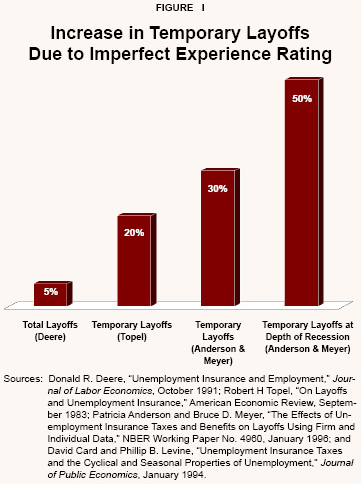
The nation’s unemployment insurance system changes behavior in harmful ways: It encourages employers to lay off workers and discourages unemployed workers from looking for new jobs. Furthermore, it treats some workers unfairly. And it provides no incentives to improve system efficiency.
“The system creates perverse incentives for employers to lay off workers.”
Encouraging Layoffs. The unemployment insurance system increases unemployment by creating perverse incentives for employers to lay off workers. It does so by shielding employers and their workers from the true cost of layoffs. Under current tax codes, an individual firm’s tax rate is adjusted according to how many of their laid off workers file claims for benefits. This experience rating varies from state to state, however, and all states have floors and ceilings on the tax rates. As a result, there is no penalty when a company already paying the maximum tax rate lays off one more worker. Even a company paying the minimum tax rate may not be penalized by a small layoff. Also, the tax schedules in some states are not actuarially related to the costs different employers impose on the system. Thus, the system itself insulates many companies from the economic impact of their own layoffs.
“It reduces the need for seasonal employers to pay a wage premium or provide off-season employment.”
This is especially true for businesses with a variable need for labor. These firms may be in very cyclical industries, such as capital goods manufacturing, or in seasonal industries such as food processing. If not for the safety net of unemployment insurance, these employers would have to offer a wage premium to attract employees from other employers who offer year-round, regular employment. To minimize the size of the wage premium, employers would seek ways to stabilize their employment. For instance, a company that normally produces goods after an order is received, might produce in advance, anticipating inventory needs during slack times. Or, a company that would otherwise contract out for equipment renovation might train production workers to do the job in-house during the off season. Unemployment insurance reduces or eliminates the need for these employers to pay a wage premium or provide off-season employment. 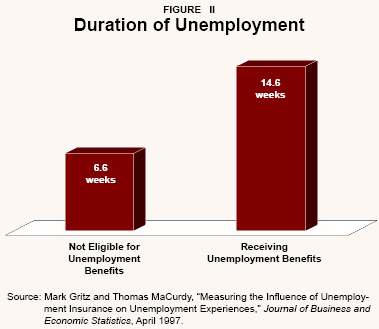
“During the depths of a recession, the system itself may cause as much as 50 percent of all temporary layoffs.”
All of the econometric studies on the subject have concluded that the unemployment insurance system in the United States induces layoffs. Figure I, which summarizes the results of these studies, shows that during the depths of recession, the system itself may cause as much as 50 percent of all temporary layoffs. 1
“The system imposes a 50 percent tax on low-wage workers who find a new job.”
Discouraging Job Search. Unemployment insurance benefits discourage unemployed workers from actively seeking a new job. For instance, until low-wage workers exhaust the benefits, their loss upon reemployment acts as a 50 percent tax, in addition to all other taxes. Since leisure itself is valuable, an individual may prefer not to work while benefits are available rather than receiving twice as much pre-tax income while working.Thus the way benefits are paid is itself a disincentive to reemployment. Research supports the idea that the unemployed respond to these economic incentives:
- Workers eligible for UI benefits are unemployed longer than those who are ineligible. 2 [See Figure II.]
- Workers who are offered bonuses for rapid re-employment find work faster than typical workers receiving unemployment benefits, and their new wages are slightly better (contradicting the claim that longer job searches produce better-paying jobs).
- The probability of an unemployed worker finding a job rises dramatically the week before the end of the person’s eligibility for unemployment insurance. 3 [See Figure III.]
“The probability of finding a job rises dramatically the week before unemployment insurance benefits run out.”
Studies of other developed countries, including Canada, Spain and Sweden, and of Europe generally, have come to similar conclusions. 4
It is commonly assumed that the unemployed cannot find work until there is a net gain of employment in the economy. Reality is quite different. Normal turnover occurs all the time: people retire, quit for personal reasons or are fired for cause. There is also job churn, in which some companies expand and others are newly formed at the same time that other firms contract or die. Both turnover and churn create far more job opportunities than net new employment. For example, more than 50 percent of workers in Oregon were newly hired during a year in which net job growth was only two percent. 5 Since there are many job openings, an unemployed person can substantially hasten his or her reemployment through more active work search.
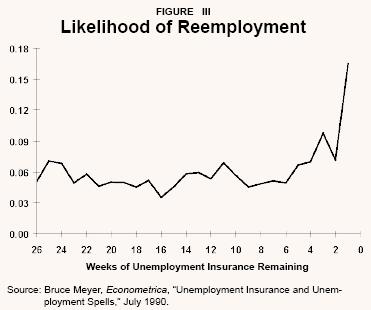
The intensity of job search is a major factor affecting how long a person remains unemployed. It is certainly the major factor that the unemployed person controls. Search intensity will vary even among people who are in their prime working years and the sole support of their families. Consider an unemployed person’s work search effort. Suppose that on Monday morning he writes a letter in response to a classified job ad; he calls a friend to ask if there are any openings with the friend’s employer; and he visits a third company and fills out an application. It’s now noon on Monday. What does our job-seeker do? He can wait to see if any of these three inquiries bear fruit, or he can spend his afternoon making more inquiries. It is human nature to put off the things that we don’t care to do, things that make us feel uncomfortable or embarrassed. One doesn’t have to label a person “lazy” to see human nature at work. We have all put off tasks that we find distasteful, even if necessary.
“Unemployment insurance taxes workers who are ineligible for benefits.”
The disincentive effect of unemployment benefits probably has the greatest impact on individuals at the margin of the employment decision. 6 They are at the margin because they value other uses of their time almost as much as work. These include mothers with small children, students and retirees. [See the sidebar: Decisions at the Margin.]
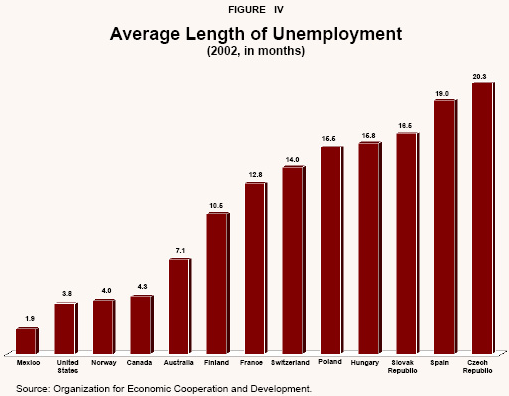
“Those who stay consistently employed receive no benefit for the taxes they pay.”
A small subset of the millions of workers who file unemployment claims each year will remain unemployed a year or more. The longer a person is unemployed the more difficult it is to become reemployed — due to the loss of work habits, outdated skills or growing gaps in the work history. Some job seekers mistakenly think a longer work search will lead to a higher-paying job. Yet empirical research shows that it does not. 7 On occasion, Congress has extended unemployment benefits in regions or states that have higher than average unemployment rates. Congress also created a special program, Trade Adjustment Assistance, which pays benefits to workers displaced by foreign competition for up to two years. Such extended benefits, however, contribute to the problem of long-term unemployment. In countries that provide more generous benefits than the United States, and do so for two or more years, the average length of unemployment is much longer. 8 [See Figure IV.]
“The average length of unemployment is much longer in countries that provide more generous benefits.”
Treating Workers Unfairly. The unemployment insurance system treats many workers unfairly. It taxes workers who are ineligible for benefits, and those who stay consistently employed receive no benefit in exchange for the taxes they pay. The length of time an individual receives benefits often depends on factors beyond his or her control, such as at what point during a business cycle the layoff occurs, and how many other workers in the state are unemployed. Ironically, the current system often does not provide benefits to some low-wage workers. This occurs because in order to qualify for benefits, workers must have a minimum employment history. Thus, workers who are employed seasonally, in cyclical industries, or only part-time may not qualify for benefits, even though their wages were taxed to support the system.
“The average state loses about 9 percent of its funds to erroneous or fraudulent benefit claims and payments.”
Encouraging Inefficiency. The current system provides no incentives to state agencies to reduce administrative costs or fraudulent claims, or to speed up reemployment. Yet there are potential cost savings in each of these areas. The average state loses about 9 percent of its funds to erroneous or fraudulent benefit claims and payments, and some states lose nearly 20 percent of their funds. 9 Workers who quit voluntarily or are fired “for cause” are usually ineligible for benefits. However, settling benefit disputes requires a system to adjudicate claims. This delays benefit payments and adds to overhead costs. In one state, for example, the cost of determining whether a worker’s job separation qualifies for benefits and adjudicating disputed claims adds up to 22 percent of the state’s total administrative costs. A separate federal unemployment tax trust fund reimburses state administrative costs, which were $3 billion in 2002. These funds cannot be used to pay benefits, and benefit funds cannot be used for administration. The inflexible wall between the two funds means that a state cannot use benefit funds to pay for administrative initiatives — such as work search assistance — that could eventually save benefit funds. This reduces states’ ability to deliver services more efficiently.
[page]Like Social Security, unemployment insurance is funded by payroll taxes. People who are working pay the benefits of people who are not. Like Social Security, there is a federal trust fund. In this case, the fund reimburses state governments for administration costs, while benefits are paid from state trust funds. Like the current proposals to reform Social Security with personal accounts, so that workers’ savings will fund part of their retirement benefits, a second personal account could be established that sets aside a portion of payroll taxes to pay unemployment benefits. During periods of unemployment, workers could draw on their unemployment funds, together with investment returns. If they do not use the funds during periods of unemployment, they could access it when they retire.
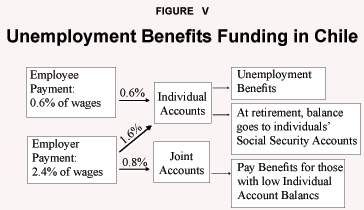
“Chile leads the world in the creation of individual accounts for unemployment insurance.”
Chile , which led the world in establishing individual social security accounts for retirees, has also led in the creation of individual accounts for unemployment insurance. 10 Economist Martin Feldstein first proposed the idea in 1975; Chile began implementing a system in 2002, building on its success with individually-owned retirement accounts. It works like this:
- Workers pay 0.6 percent of their wages into individual accounts, while employers pay a 2.4 percent payroll tax divided between individual accounts and a “joint account” that pays benefits to new or low-wage workers when their accounts are exhausted.
- The accounts are administered by the same private pension funds that manage Chilean workers’ retirement accounts and are invested conservatively in a variety of securities.
- The individual account is held in the worker’s name and is paid out when the worker becomes unemployed or retires. [See Figure V.]
- After a worker’s account is sufficiently funded to support five months of benefits, taxes are paid directly to the employee, not the unemployment account.
- Unemployed individuals with fully funded accounts will be able to draw 30 percent to 50 percent of their previous wages for up to five months at a time.
America’s system of personal accounts need not duplicate the Chilean system. However, there are some elements in the Chilean system that we believe are critical for the success of an American program:
- Each worker in the personal account system has his or her own account, funded like the current system, by employer taxes.
- A backup system, also funded by employer taxes, covers those who have not built up a large enough individual account balance to cover their unemployment benefits.
- Another option would be to allow loans from the joint account to the individual accounts of unemployed workers whose balances are too small to meet their living expenses, to be paid back out of the workers’ future earnings. 11
- Unused balances in individual accounts could be withdrawn in cash or rolled into a personal retirement account when the worker retires.
Employment Benefits of Individual Accounts. The biggest problem with the current unemployment insurance system: It discourages rapid reemployment. Individual accounts solve this problem. Workers with individual accounts will feel urgency about their reemployment, because finding new work rapidly allows them to add to their retirement income. In Chile, the UI administrator trains the worker to understand the connection between unused unemployment funds and retirement income by mailing the employee’s annual unemployment insurance account statement in the same envelope as one of his quarterly individual social security account statements. 12
“Chileans can draw upon their funds even if they quit or are fired.”
Unlike the U.S. unemployment system, Chileans can draw upon their funds even if they quit or are fired from their last jobs. This allows workers more flexibility in changing employment, thus reducing the need for costly adjudication of claims.
“Individuals can draw from their accounts when they become unemployed or retire.”
Implementation Issues. A personal account system in the United States would be easy for states to administer. Current state-run systems raise issues when people move from one state to another. If people are nervous about changing to a new system, it need not be mandatory. States could offer traditional unemployment insurance in exchange for employer contributions. With good experience rating of employer taxes, the system could pay for itself. However, workers should not be allowed to change back and forth between the two systems, as this could make both systems financially unstable.
“An American individual account system could be funded by existing employment taxes.”
How can we finance a system of personal accounts? Over time, the system would be self-funded through existing employment taxes. Existing trust funds would pay for the transition (the federal trust fund for administration and the state trust funds for benefits) and the balances of both funds could be applied toward financing individual accounts.
[page]Proposals to change the unemployment insurance system tend to be predictable products of two opposing camps. Business lobbies want to make marginal changes that limit benefit eligibility, such as clarifying that dismissal for drug usage disqualifies a person from benefits. Unions and worker advocates want to expand eligibility and increase benefits. Both groups are focused on minor changes that do not disturb the underlying structure of the system.
“Federal action is needed to reform the system.”
Since unemployment insurance is a federally-mandated, state-administered program, fundamental reforms require federal action. First steps could include individual states determining how they want to provide benefits; they could use the best state workers’ compensation programs as models for reform. If administrative and benefits funding were combined, and the system was managed by for-profit contractors, financial incentives would be properly aligned to control costs and encourage rapid reemployment. 13
“States need the flexibility to design their own benefit systems.”
Unlike unemployment insurance, there is no national mandate for the workers’ compensation system, which covers medical expenses and lost wages for workers injured on the job. All states have adopted some kind of program, and their freedom to experiment has led to different solutions. Similarly, if states had the flexibility to design their own benefit systems, including the ability to allocate both state and federal payroll tax funds as they chose, their experiments would produce model programs that could be copied in other states. For example, although workers’ comp coverage is mandatory in all states except Texas, most states allow private insurers to compete for the business of individual employers and allow employers to self-insure. In a number of states, government funds or insurers compete with the private sector. And in recent years, states have increasingly deregulated the market for workers’ comp insurance. For instance, between 1980 and 2000, the number of states where insurers are free to set their own rates, called “open competition,” increased from one to 37. Since employers can substantially lower their insurance rates by reducing the number of claims, programs to promote work safety have contributed to steadily falling injury rates. 14
“Eligibility review interviews save states an estimated $10 for every $1 spent.”
By contrast, unemployment insurance is federally mandated and highly regulated. If federal policymakers allowed each state to design its own unemployment insurance system, a variety of state experiments would ensue. 15
State Experimentation. Several state experiments suggest that incentives for more rapid reemployment can reduce both the length of unemployment and benefit costs. These incentives could be used in reformed state UI programs; however, the experiments have been limited in scope because only changes in federal law would give states flexibility in program design. Following is a description of some of the efforts that have been made.
Seminars on work search techniques have proved effective in prompting reemployment. Interestingly, though, two separate studies have found that most of the effect of the seminars occurs before they are held, but after participants are notified that they are required to attend. 16 People would rather find work than attend a seminar!
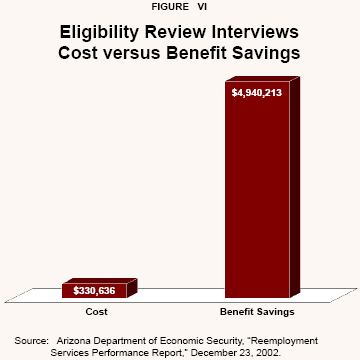
Another trial program, in Arizona, provided more intense supervision of unemployed workers. Administrative staff interviewed recipients on a regular basis to set goals and monitor their progress. The extra attention discouraged procrastination and provided emotional support for the workers’ job search efforts. As shown in Figure VI, the state estimated a savings in benefits of about $10 dollars for every $1 spent on administering the program. Unfortunately, the program was discontinued because the special grant used to fund it was exhausted. The benefits saved could not be used to continue the program. 17
“Search assistance from employers, subsidies for job creation, use of staffing agencies and making worker profiles available — all could be effective reforms.”
Search Assistance from Employers. Given the right incentives — such as access to UI funds — employers may be willing to assist former employees in finding new jobs. In one private program, a consortium of employers is providing work search assistance to the workers they lay off. The assistance takes the form of weekly telephone calls that offer services such as résumé preparation, as well as encouragement. Typically, the caller reviews the job seeker’s work search plan for the coming week, asks if the seeker needs any assistance, and then schedules a follow up call. The scheduled call hastens activities that lead to reemployment by counteracting the normal human tendency to procrastinate and providing accountability. Rough estimates show that the program saves $2 in benefit costs for each $1 of administrative costs. 18
Subsidies for Job Creation. Employers administering unemployment insurance might want to experiment with other approaches, such as subsidies for job creation. An Oregon experiment used money that would otherwise have funded unemployment benefits to subsidize programs that created jobs for people with relatively low skills and little experience. Program employees were assigned a mentor to coach them on basic job skills, such as arriving on time, following instructions, and getting along with coworkers. The program was found to save more in benefits than it cost. 19
Use of Staffing Agencies. Another opportunity that apparently is not being exploited is the increasing the visibility of staffing companies. The staffing industry — primarily temporary help agencies — could place many workers. State employment agencies should allow these agencies to rent space in their lobbies for the purpose of signing up potential workers. In addition to a paycheck, temporary jobs expose the workers and the employers to each other, which often results in offers of permanent employment.
Making Worker Profiles Available. Public availability of information about job-seekers could potentially speed up hiring. Delays between when a company wants to hire and when it finds the right worker are a deadweight loss to society. Reducing this friction will increase output. Computerized databases, accessible to any employer, could provide information about skills, experience and interests of job seekers. The system could be coded to allow employers to contact job seekers while protecting privacy.
[page]A free society is marked by experimentation and variation, but there is little experimentation and variation in the U.S. unemployment insurance system. The public desire for a safety net can be met in a way that preserves incentives for reemployment, without providing artificial incentives for layoffs. Individual accounts for unemployment insurance most directly address the unemployed person’s disincentive to reemployment.
If the United States implemented a system of individual accounts, it would eliminate employer incentives to lay off workers. The cost of benefits would no longer be shifted from workers with unstable employment to workers with stable employment. Workers would demand a wage premium for unstable employment to make up for the smaller account balance expected at retirement. The safety net for workers who are new to the labor force or are frequently unemployed could be funded by experience-adjusted tax rates. Workers would have an incentive to find new jobs quickly, so that they will have more money in their accounts at retirement.
Private administration of unemployment insurance also offers the potential for improved performance through appropriate encouragement, as well as sanctions for failure to engage in active work search. We know that unless it is reformed, the mandatory monopoly entitlement program will continue to cause higher unemployment and a waste of human resources.
NOTE: Nothing written here should be construed as necessarily reflecting the views of the National Center for Policy Analysis or as an attempt to aid or hinder the passage of any bill before Congress.
[page]- Patricia Anderson and Bruce D. Meyer, “The Effects of Unemployment Insurance Taxes and Benefits on Layoffs Using Firm and Individual Data,” National Bureau of Economic Research, NBER Working Paper No. 4960, January 1996; Patricia Anderson and Bruce D. Meyer, “The Effects of the Unemployment Insurance Payroll Tax on Wages, Employment, Claims and Denials,” National Bureau of Economic Research, NBER Working Paper No. 6808, November 1998; Frank Brechling and Louise Laurence, Permanent Job Loss and the U.S. System of Financing Unemployment Insurance (Kalamazoo, Mich.: W. E. Upjohn Institute for Employment Research, 1995); David Card and Phillip B. Levine, “Unemployment Insurance Taxes and the Cyclical and Seasonal Properties of Unemployment,” Journal of Public Economics, vol. 53, no. 1, January 1994, pages 1-29; Donald R Deere, “Unemployment Insurance and Employment,” Journal of Labor Economics, vol. 9, no. 4, October 1991, pages 307-24; Robert H Topel, “On Layoffs and Unemployment Insurance,” American Economic Review, vol. 73, September 1983, pages 541-559.
- A. Colin Cameron, R. Mark Gritz and Thomas MaCurdy, “The Effects of Unemployment Compensation on the Unemployment of Youth,” NLS Discussion Paper, NLS 92-4, 1989; R. Mark Gritz and Thomas MaCurdy, “Measuring the Influence of Unemployment Insurance on Unemployment Experiences,” Journal of Business and Economic Statistics, vol. 15, no. 2, April 1997; Pierre Yves Cremiéux, Pierre Fortin, Paul Storer and Marc Van Audenrode, “Unemployment Insurance and Job Search Productivity,” Human Resources Development Canada, August 1995; Arellano, Manuel, Olympia Bover and Samuel Bentolila, “Unemployment Duration, Benefit Duration and the Business Cycle,” Centre for Economic Policy Research Discussion Paper 1840, March 1998.
- Bruce D. Meyer, “Unemployment Insurance and Unemployment Spells,” Econometrica, vol. 58, no. 4, July 1990, pages 757-82M
- On Canada, see Pierre Yves Cremiéux, Pierre Fortin, Paul Storer and Marc Van Audenrode, “Unemployment Insurance and Job Search Productivity,” Human Resources Development Canada, August 1995; and Christian Belzil, “Unemployment Insurance and Subsequent Job Duration: Job Matching vs. Unobserved Heterogeneity,” Journal of Applied Econometrics, Sept-Oct 2001, pages 619-636. On Europe, see Olivier Blanchardand Justin Wolfers, “The Role of Shocks and Institutions in the Rise of European Unemployment: The Aggregate Evidence,” Economic Journal, vol. 110 (March 2000), pages C1-C33. On Spain, see Manuel Arellano, Olympia Bover and Samuel Bentolila, “Unemployment Duration, Benefit Duration and the Business Cycle,” Centre for Economic Policy Research Discussion Paper 1840, March 1998; and on Sweden, see Kenneth Carling, Bertil Holmlund and Altin Vejsiu, “Do Benefit Cuts Boost Job Finding? Swedish Evidence from the 1990s,” Economic Journal, October 2001.
- Oregon Employment Department, “Oregon’s Workforce Puzzle: More Than Supply and Demand,” August 2001.
- Eric M. Engen and Jonathan Gruber, “Unemployment Insurance and Precautionary Saving,” NBER Working Paper No. 5252 (September 1995); Jonathan Gruber, “The Consumption Smoothing Benefits of Unemployment Insurance,” American Economic Review, vol. 87, no. 1, March 1997, pages 192-205; Jonathan Gruber, “The Wealth of the Unemployed: Adequacy and Implications for Unemployment Insurance,” Industrial and Labor Relations Review, forthcoming. Also NBER Working Paper No. 7348, September 1999; Jonathan Gruber and Julie Berry Cullen, “Does Unemployment Insurance Crowd Out Spousal Labor Supply?” Journal of Labor Economics, vol. 18, no. 3, July 2000, pages 546-572.
- Bruce D. Meyer, “Lessons from the U.S. Unemployment Insurance Experiments,” Journal of Economic Literature, vol. 33, no. 1, March 1995, pages 91-131.
- William B. Conerly, “European Unemployment: Lessons for the United Sates,” National Center for Policy Analysis, Brief Analysis No. 475, May 26, 2004.
- William B. Conerly, “Wasting Billions on Unemployment Insurance Overpayments,” National Center for Policy Analysis, Brief Analysis No. 458, September 30, 2003.
- William B. Conerly, “ Chile Leads the Way With Unemployment Accounts,” National Center for Policy Analysis, Brief Analysis No. 424, November 11, 2002.
- These would probably be nonrecourse loans, so a worker who retires with a deficit account would not be obligated to repay it.
- Communication from Patricio Eskenazi, University of Chicago graduate student, March 2, 2005.
- The structure of administrative funding, and the Bush administration’s proposals to devolve administrative funding to the states, are discussed in William B. Conerly, “Give the States Back Their Money,” Intellectual Ammunition, May/June 2002, Heartland Institute.
- William B. Conerly, “Is Workers Compensation a Model for Unemployment Insurance?” National Center for Policy Analysis, Brief Analysis No. 435, April 11, 2003.
- William B. Conerly, “Allowing the States to Innovate,” Regulation Magazine, Spring 2003, Cato Institute.
- Dan. A. Black, Jeffrey A. Smith, Mark C. Brueger and Brett J. Noel, “Is the Threat of Reemployment Services More Effective Than the Services Themselves? Evidence from Random Assignment in the UI System,” American Economic Review, September 2003, pages 1313-1327. See also an account of an earlier experiment in Terry R. Johnson and Daniel H. Klepinger, “Experimental Evidence on Unemployment Insurance Work Search Policies,” Journal of Human Resources, vol. 29, no. 3, Summer 1994, pages 695-717.
- Arizona Department of Economic Security, “Reemployment Services Performance Report,” December 23, 2002.
- The consortium has asked to remain anonymous. It has several large operations in a major metropolitan area. The manager of the program believes that the major impact comes because job seekers try to show progress at every weekly telephone call. However, he believes that further progress could be made if they contested claims being paid to those making little effort to find a new job.
- William B. Conerly and John W. Courtney, “Final Report on the JOBS Plus Program,” American Institute for Full Employment, March 1, 2001.
William B. Conerly, Ph.D., is a senior fellow of the American Institute for Full Employment (http://www.fullemployment.org/), which supported this research. He is also principal of Conerly Consulting LLC of Lake Oswego, Oregon, and a senior fellow at the National Center for Policy Analysis. He can be reached at Bill@ConerlyConsulting.com.